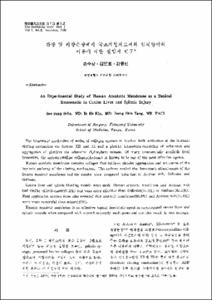간장 및 비장손상에서 국소지혈제로써의 인체양막의 이용에 대한 실험적 연구
- Keimyung Author(s)
- Sohn, Soo Sang; Kim, In Ho; Kang, Joong Shin
- Department
- Dept. of Surgery (외과학)
- Journal Title
- Keimyung Medical Journal
- Issued Date
- 1988
- Volume
- 7
- Issue
- 2
- Abstract
- The hemostatic mechanism of action of collagen appears to involve both activation of the intrinsic clotting mechanism via factors XII and XI and a platelet interaction consisting of adherence and aggregation of platelets vis adenosine diphosphate release. Of many commercially available local hemostats, the microcrystalline collagen(Avitene) is known to be one of the most effective agents. Human amniotic membrane contains collagen that initiates platelet aggregation and activation of the intrinsic pathway of the clotting mechanism. The authors studied the hemostatic effectiveness of the human amniotic membrane and the results were compared with that of Avitene web, Collastat and Gelfoam. Canine liver and splenic bleeding models were used. Human amniotic membrane and Avitne web had similar effectiveness(97.2%) and were more effective than Collastat(77.8%) or Gelfoam(61.1%). First application success rates also revealed that amniotic membrane(80.6%) and Avitene web(77.8%) were more successful than others(47%). Human amniotic membrane is an effective topical hemostatic agent in experimental canine lever and splenic wounds when compared with several currently used agents and can also result in cost savings.
- Alternative Title
- An Experimental Study of Human Amniotic Membrane as a Topical Hemostatic in Canine Liver and Splenic Injury
- Publisher
- Keimyung University School of Medicine
- Citation
- 손수상 et al. (1988). 간장 및 비장손상에서 국소지혈제로써의 인체양막의 이용에 대한 실험적 연구. Keimyung Medical Journal, 7(2), 330–334.
- Type
- Article
- Appears in Collections:
- 2. Keimyung Medical Journal (계명의대 학술지) > 1988
1. School of Medicine (의과대학) > Dept. of Surgery (외과학)
Items in Repository are protected by copyright, with all rights reserved, unless otherwise indicated.
